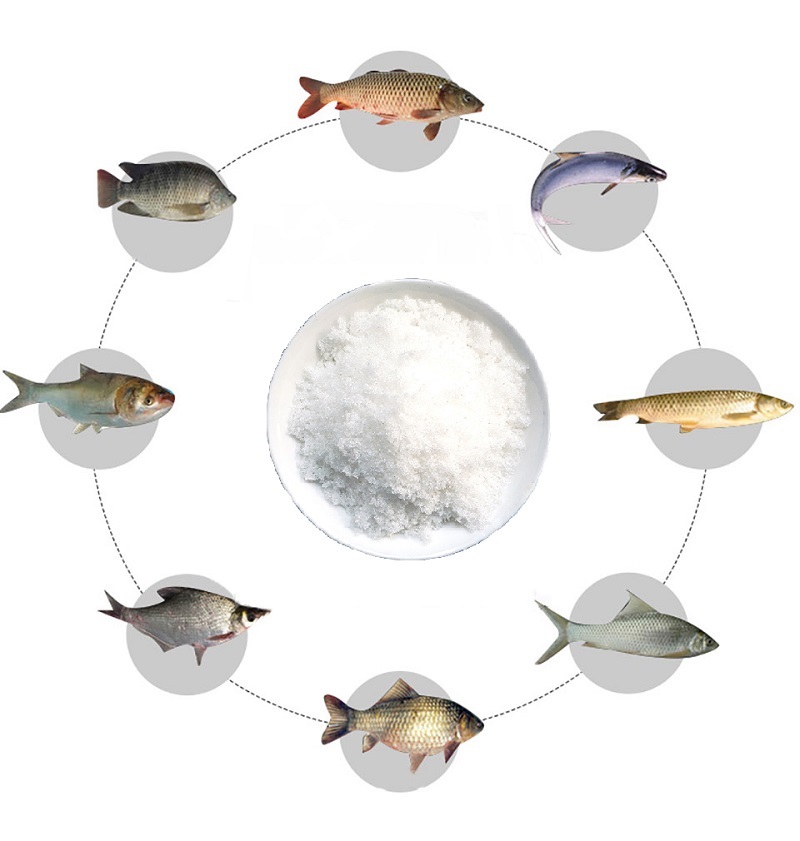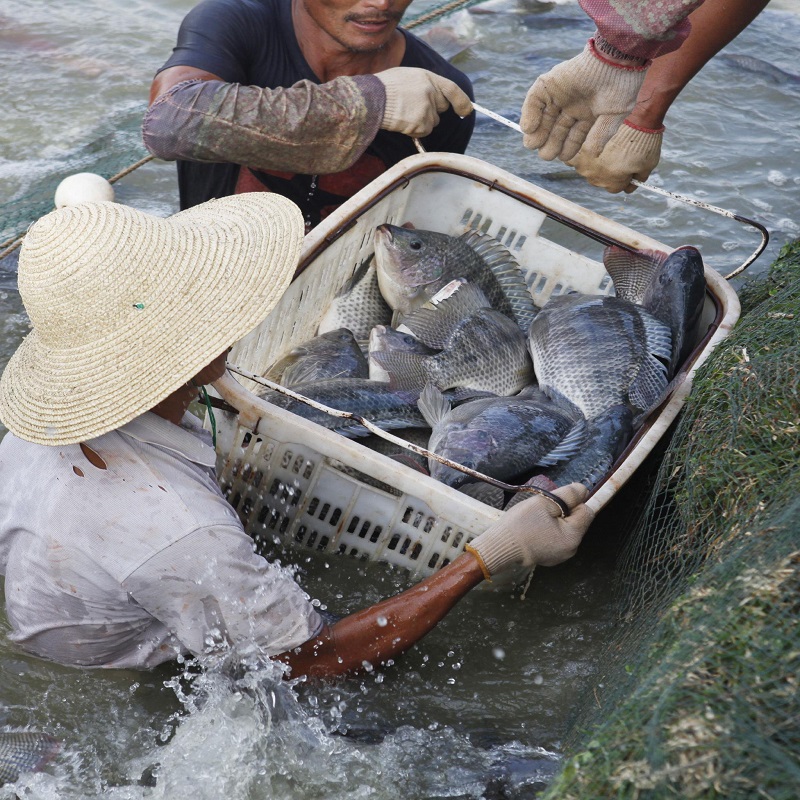High strength attractants DMPT and DMT are new and efficient attractants for aquatic animals. In this study, high-strength attractants DMPT and DMT were added to carp feed to investigate the effects of the two attractants on carp feeding and growth promotion. The results showed that the addition of high-strength attractants DMPT and DMT to the feed significantly increased the biting frequency of the experimental fish and had a significant feeding effect; At the same time, the addition of different concentrations of high-strength attractants DMPT and DMT to the feed significantly increased the weight gain rate, specific growth rate, and survival rate of the experimental fish, while the feed coefficient decreased significantly. The research results also indicate that DMPT has a more significant effect on attracting and promoting the growth of carp compared to DMT.
Aquatic animal feed attractant is a non nutritive additive. Adding attractants to feed fish can effectively promote their feeding, increase their food intake, reduce residual feed in water, and thus alleviate pollution in aquaculture water bodies. DMPT and DMT are active substances widely present in marine organisms, serving as effective methyl donors and important osmotic pressure regulators. They also have significant feeding and growth promoting effects on aquatic animals.

After conducting relevant studies on aquatic animals such as crucian carp, red snapper, goldfish, and spotted shrimp, Japanese researchers found that DMPT and DMT have good attractant effects on freshwater and marine fish, crustaceans, and shellfish. Supplementing low concentrations of high-strength attractants DMPT and DMT in feed can greatly accelerate the feeding and growth of various freshwater and marine fish. In this experiment, high-strength attractants DMPT and DMT were added to carp feed to study their effects on carp feeding and growth promotion, providing reference data for the widespread application of these two new attractants in the feed and aquaculture industries.
1 Materials and Methods
1.1 Experimental materials and experimental fish
S. S' - Dimethylacetic acid thiazole (DMT), DMPT
The experimental carp were taken from an aquaculture farm, with healthy bodies and neat specifications. Before the experiment officially begins, the experimental fish will be temporarily raised in the laboratory for 7 days, during which they will be fed with carp feed provided by the feed factory.
1.2 Experimental feed
1.2.1 Lure test feed: Crush the carp feed provided by the feed factory, add an equal amount of A-starch, mix evenly, and mix with an appropriate amount of distilled water to make 5g sticky balls each as the control group feed. At the same time, prepare bait feed by first crushing carp feed, adding an equal amount of alpha starch, and adding bait DMT and DMPT at two concentrations of 0.5g/kg and 1g/kg, respectively. Mix evenly and mix with an appropriate amount of distilled water to make each 5g sticky ball.
1.2.2 Growth test feed:
Crush carp feed (from the same source as above) into powder, pass it through a 60 mesh sieve, add an equal amount of alpha starch, mix thoroughly, mix with distilled water, squeeze it from the sieve into granules, and air dry it to obtain the control group feed for the growth test. The synthesized DMT and DMPT crystals were dissolved in distilled water to prepare a solution of appropriate concentration, which was used to mix the thoroughly mixed carp feed and starch into granules. After drying, the experimental group feed was obtained, with DMT and DMPT added in three concentration gradients of 0.1g/kg, 0.2g/kg, and 0.3g/kg, respectively.

1.3 Test Method
1.3.1 Lure test: Select 5 experimental carp (with an average weight of 30g) as the test fish. Before the test, starve for 24 hours, and then place the test fish in a glass aquarium (with a size of 40 × 30 × 25cm). The lure feed is fixed at a distance of 5.0cm from the bottom of the aquarium using a suspended line tied to a horizontal bar. The fish bites the bait and vibrates the line, which is transmitted to the horizontal bar and recorded by a wheel recorder. The frequency of bait biting is calculated based on the peak vibration of 5 test fish biting the bait within 2 minutes. The feeding test for each group of feed was repeated three times, using newly prepared feeding adhesive balls each time. By conducting repeated experiments to obtain the total number and average frequency of baiting, the feeding effect of DMT and DMPT on carp can be evaluated.
1.3.2 The growth experiment uses 8 glass aquariums (size 55 × 45 × 50cm), with a water depth of 40cm, natural water temperature, and continuous inflation. The experimental fish were randomly assigned and divided into two groups for the experiment. The first group consists of four aquariums, numbered X1 (control group), X2 (0.1gDMT/kg feed), X3 (0.2gDMT/kg feed), X4 (0.3gDMT/kg feed); Another group of 4 aquariums, numbered Y1 (control group), Y2 (0.10g DMPT/kg feed), Y3 (0.2g DMPT/kg feed), Y4 (0.30g DMPT/kg feed). 20 fish per box, fed 3 times a day at 8:00, 13:00, and 17:00, with a daily feeding rate of 5-7% of body weight. The experiment lasted for 6 weeks. At the beginning and end of the experiment, the wet weight of the test fish was measured and the survival rate of each group was recorded.
2.1 The feeding effect of DMPT and DMT on carp
The feeding effect of DMPT and DMT on carp is reflected by the biting frequency of the experimental fish during the 2-minute experiment, as shown in Table 1. The experiment found that after adding DMPT and DMT feed to the aquarium, the experimental fish quickly showed active foraging behavior, while when using the control group feed, the reaction of the experimental fish was relatively slow. Compared to the control feed, the experimental fish had a significant increase in the frequency of biting the experimental feed. DMT and DMPT have significant attractant effects on experimental carp.
The weight gain rate, specific growth rate, and survival rate of carp fed with different concentrations of DMPT were significantly increased compared to those fed with control feed, while the feed coefficient was significantly reduced. Among them, the addition of DMPT to T2, T3, and T4 increased the daily weight gain of the three groups by 52.94%, 78.43%, and 113.73%, respectively, compared to the control group. The weight gain rates of T2, T3, and T4 increased by 60.44%, 73.85%, and 98.49%, respectively, and the specific growth rates increased by 41.22%, 51.15%, and 60.31%, respectively. The survival rates increased from 90% to 95%, and the feed coefficients decreased by 28.01%, 29.41%, and 33.05%, respectively.
3. Conclusion
In this experiment, whether DMT or DMPT was added, the feeding frequency, specific growth rate, and daily weight gain of the experimental fish in each group were significantly increased compared to the control group, while the feed coefficient decreased significantly. And whether it is DMT or DMPT, the growth promoting effect becomes more significant with the increase of the addition amount in the three concentrations of 0.1g/kg, 0.2g/kg, and 0.3g/kg. At the same time, a comparison of the feeding and growth promoting effects of DMT and DMPT was made. It was found that under the same concentration of haircuts, the feeding frequency, weight gain rate, and specific growth rate of the experimental fish in the DMPT feed group were significantly increased compared to the DMT feed group, while the feed coefficient was significantly reduced. Relatively speaking, DMPT has a more significant effect on attracting and promoting the growth of carp compared to DMT. This experiment used DMPT and DMT added to carp feed to explore their feeding and growth promoting effects. The results show that DMPT and DMT have broad application prospects as a new generation of aquatic animal attractants.
Post time: May-30-2025







